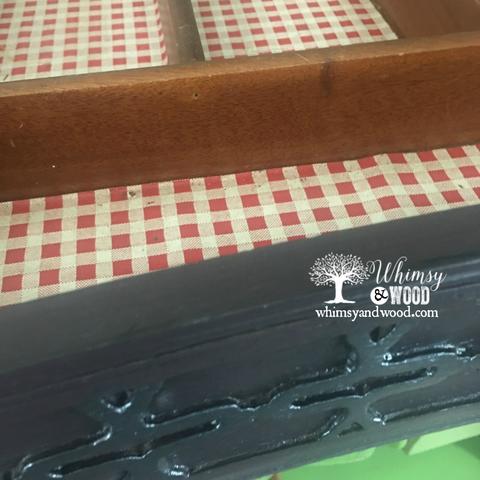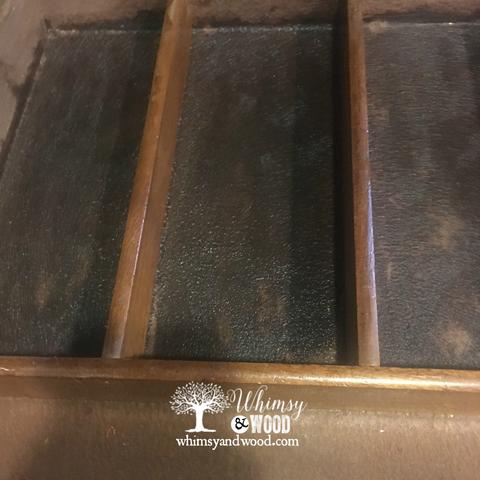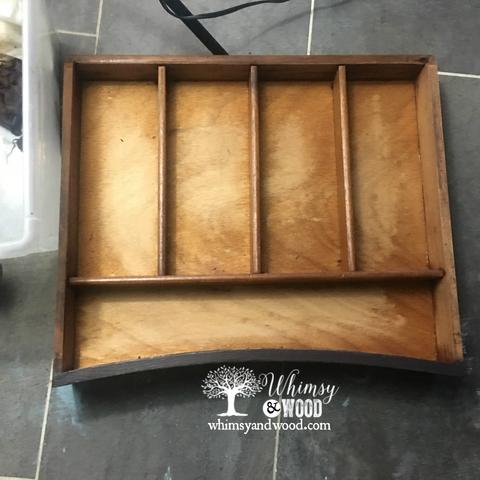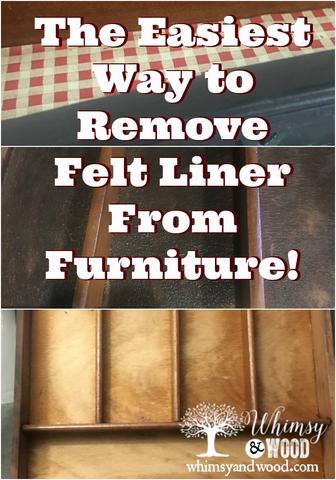Easily Remove Felt Lining from Wood!
Do you use Pinterest? I am willing to bet most of you probably arrived here from a post on Pinterest, Welcome. Pinterest comes before Google when I am looking for many how to’s in my DIY life. You may remember my talking about snowing felt when I worked on this desk. It was a mess and it is still lodged in my sander. It got the job done albeit the hard way.
A recent project I was working on also had a dank, nasty felt liner that had to be removed. This liner, however, was not on a flat surface without sides. It was in a drawer with dividers. These dividers are great for storing silverware, not for removing felt from. Side note, the nasty liner was hidden under a bizarre picnic looking shelf paper. If they had known how easy it was to remove the felt lining from wood, they would not have had to hide it under this special vinyl liner.

A Better Way to Remove Felt Lining From Wood
Searching Pinterest for the answer I found post after post of get a putty knife, get to scraping, then sand it, and then either live with any fibers left over or scrape again. I might have painted the dank liner before embarking on that mess!
I got to thinking & in the past I have used a combo of water & a heat gun for removing veneer. I assume that the glue for old veneer is probably the same or a similar glue for old felt.
I decided to wet/saturate the liner and hope that it was the same animal hyde based glue. (Does picturing glue from animal hyde makes you uncomfortable too? Blech!!) The bonus of this glue is that it is water soluble. Guess what it was a good idea & it worked which is why we are talking about it now.
Supply List for Removing Felt Lining From Wood
Disclosure: Post contains affiliate links for your convenience.
- Room temperature water
- Something to pierce and get the liner.
- (I used a tool that is meant for turning eyelet screws. You could also use an awl, or maybe even a fork.)
- Scrub sponge
Cheap & easy list to pull together right? You’re welcome.

Step 1
It Really Is This Simple to Remover Felt Liner From Wood
As shown in this photo, saturate your felt liner.
- Pour room temperature water onto your felt liner and allow it to penetrate to the point where the felt is soaked.
- Then pour the remaining water out.
- Allow the wet felt to sit for about 2-3 minutes.
Step 2
How To Lift the Felt Liner For Easy Removal
- Pierce the felt using your awl or whatever sharp object you are working with.
- Once you pierce it, lift up with your tool.
- The glue should have begun breaking up & it will release the liner.
- Pull the felt up and wiggle it loose. If it fights you, try a little more water.
I pierced the felt and began lifting up. At first, I was worried (you will notice in the video at the bottom that it looked to be breaking and tearing & I was hoping for pull it all of in one swoosh) For this one I got it started with the awl type tool & then used my fingers to pull and lift out. The felt was very old & worked better with the hand tugging. The piercing tool was just shredding it when I tried to pull back.
Step 3
Cleaning the Wood After Removing the Felt Liner.
Once the felt liner was removed I expected to need to sand it. Instead, I got a scrubber with hot water and gave a light scrubbing. Less than you would a pan with baked on stuff. The whole process was less than 10 minutes and required no hard work.
I actually returned to Pinterest to see if anyone had told these well-intentioned scrapers that there was a better way.
Do your friends (and me, we are friends right?) a favor and share this post!
Below you can watch a basic video of the process. Remember when I started I was not sure it was going to work. There was a chance you would have never even seen this video so it’s a little cheesy & I call a trowel a spatula because I have a little bit of amnesia with words sometimes… Anyhow, I hope my embarrassingly imperfect video helps you. 🙂


Pinterest Pins:

Thank you so much for this useful tip, my project was an old sectioned cutlery box, removing the assorted partitions was the hardest part-after bending a couple of fine chisels used one of those ‘thingys’ for scraping
weeds from between flag stones to pry the sections out, it was also useful to scrape off the residue after adopting your soak method-job done!
I am so glad you found this useful!!! Thank you.
You are a legend.
I just received a free dresser, which turned out to have the nastiest felt lining in one of the drawers. So bad that it was just seconds away from ending up on the tip. But while I was still sat in my car, I googled removal of felt lining and found your post. I took the offending drawer inside to try your method. Lo and behold 10-minutes later the felt was mostly removed. A final bit of scrubbing with wire wool and it is totally useable now. The rest of the dresser is in great shape too.
Thanks so much for sharing your tips. I will never be put off by felt lining again.🤩
YES! I love hearing these successes. Thank you for visiting and sharing your experience.
Thank you for this huge time saver! I was scraping it dry and it was awful. I applied water with a fine steel wool, let it sit for a minute, and then was able to scrape it with a putty knife. Comes off like butter!
That is so great to hear! If I help 1 person then that’s what it’s all about. Thank you for visiting Jessica.
I wish I would have discovered this post a year ago when I first started my beautiful French china cabinet! I pulled off most of the felt then used GooGone to try and remove the glue residue, which is why i’m posting here now….it didn’t work! I’m now going to try the soapy water(who knew!)trick. Will let you know the outcome.
Patty, I know your pain! I have had positive feedback from those who stumbled on this post. I hope it saves you on your project. Thanks for visiting.
Hi thanks so much for making this post Jennifer!
I recently got an old real wood dresser for free which I wanted to use for my baby clothes storage. Unfortunately the top drawer was completely dusty with horrible tufted and grimy felt and 2 dividers with rhe same felt. I followed your instructions but as it was quite attached on I had to run under hot water while I used a flat head screwdriver and steel wool to scrape and scrub. Overall its got 98% off and I honestly couldn’t have done it without this advice. Thanks!
So glad to have been able to help! Sounds like yours was quite attached!
thank you!! I did stumble on this just a little late. My drawer was quite similar and I had sliced the old nasty felt with a razor blade and ripped most of it out but there is still a little under the dividers and of course the nasty residue of glue. I was afraid to do the water or blow dryer for fear it would make the stuff stick faster than it already was. Going to try the water on the remaining bits. Thanks again!
I hope it works as well for you!
Great advice. Had spent a whole evening watching a box set and prising felt off a large drawer from my grans trousseau chest. Rest of chest broken but I intend to use the very large drawer for display after painting. Not well made and wood divisions plywood but sentimental value. Brilliant way to get rid felt. Works a treat. Thanks for the advice.
I am so happy that you posted this! Helped me get the grimy felt liner out of a lovely antique dry sink that someone, years ago, thought it would be a good ideal to glue into a drawer. Not only the bottom but all four sides! I scrapped for a while and my daughter scrapped for a while and I was really ready to just throw in the towel and just live with it. Was thinking I’d have to put a drawer liner in and just cover it up. Which was never going to feel right. Decided to do a quick search to see who may have encountered this same problem and how they dealt with it. Most every site said scrape and sand. That’s so much work and frankly I just had had about enough of the scrapping!
After reading your post, I bravely put the antique drawer in the sink and ran some water and let it sit for a three minutes and then began scrapping with a small paint remover tool. It worked wonderfully! When it seemed that I had hit a wall and wasn’t able to get the remainder scraps out, which seemed to have a thicker lining maybe. I decided to run hot water and let it sit, this did the trick. Instead of using the scrapping tool at this point, I used those green scrubby pads that I reserve for stuck on food on my stainless cookware. You can actually get those at the dollar tree and they are just as good as the name brand that you pay so much more for. (That’s my tip contribution lol). Thank you for this very useful tip!
That is a great tip Sheila! It helps at the end, either way, to clean off some of the glue residue. Thank you!!
Thanks Sheila!
Got an old wooden machinist’s toolbox, and the drawers were lined with some pretty nasty, dirty green felt. I’ve had this box, sitting in my basement, for a year. I just haven’t felt the urge to do much with it. I thought I’d check out what others were doing with this stuff. I’ve gone the scraping and sanding route before, and it sucks. So, I saw your post, and figured I’d give it a try. Wow! I filled the drawers up, with warm water, and started peeling felt, immediately. Scrubbed the inside of the drawers, with a plastic scrubber, rinsed, and wiped out any residue with a paper towel. They are so nice inside, I don’t think I can bring myself, to cover them back up, with new felt. They’ll be getting a hand rubbed finish of Tru-oil.
So easy! Bought a second-hand chess table with two small drawers – felt-lined drawers. I tried scraping them, but the lining wouldn’t budge. Googled and found your method. Being lazy, I just sprayed it with some TSP I had lying around my work area, waited a minute and started ripping. So satisfying! Thank you!
AWESOME! I am so glad this post was helpful1
Thank you! You saved me so much time! I have a 34″ x 34″ puzzle table and needed the felt removed. Tried several things that didn’t work, then googled it and found your post. My daughter and I got it all off and clean in about 30 min.
LOVE IT!! Simple, free, and a game changer for felt removal❤️
Thanks so much. So much easier than the usual, ineffective scraping/sanding method.
I used warm, soapy water and the glue just seemed to liquify to a gel like substance.
Cheers Kristina
Yes!! I remember those days.. long in the pas for us now:)
THANK YOU! I had been scraping & scraping to remove the felt and I just wet it down and the felt *floated off. Thank you again.
I love hearing this was helpful!!
Thx so much for posting this!
A HUGE THANK YOU Jennifer! I had spent an hour picking away at old green felt in a cutlery drawer and was making little progress. Then I read your advice and gave it a go. Unbelievable – 10 minutes later the inside of the drawer was spotless. It absolutely worked!!!
Thank u for the advice, totally worked though I may give the inside of the drawer another pass with soap and water because I still feel a bit of glue/ stickiness. The wood working guy by me recommended a chemical but this was much easier I think. So glad I found your site.
Goodness, I’m finding this in January 2023 after purchasing a gorgeous (second hand) dining room table that had a little bit of felt stuck to two of the corners. The offending felt was stuck on a very ornate edge, and I was dismayed at the info I found online that said I’d have to sand the wood. Given the ornate carving, this was not something I wanted to do. Then today I searched Google again and your page came up. I used a sponge with a scrubby back, soaking the felt with the sponge side and then EASILY scrubbing it off with the rough side. Done in 5 minutes with no damage to the wood. Thank you!!